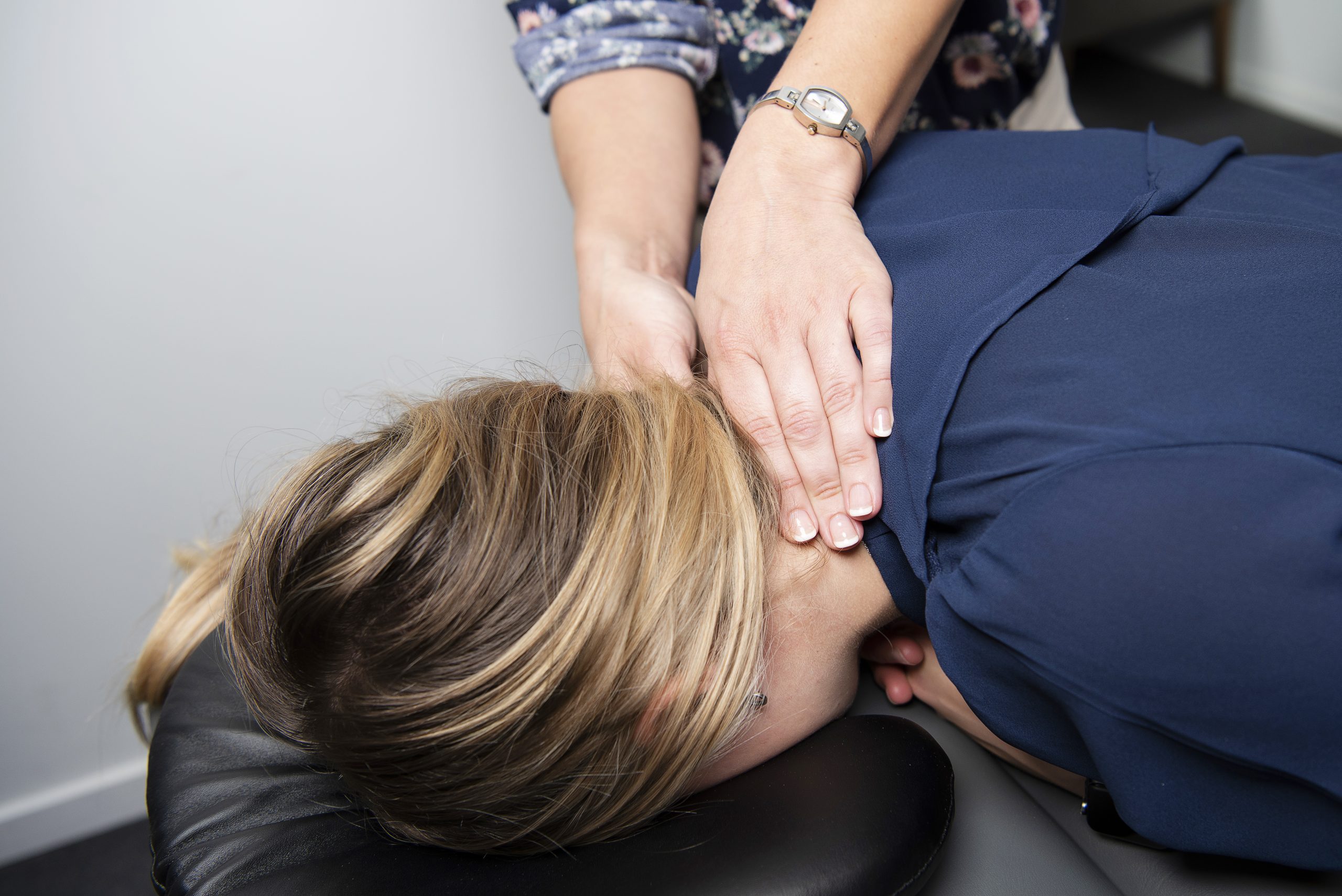Menstrual Migraine & Period Headache Treatment
The team at the Headache, Neck and Jaw Clinic provides effective treatment for menstrual migraines and period headaches to help you find relief from recurring pain.

Beyond just missing work, people with migraines suffer in many areas of life. They might cause parenting struggles, or force you to miss time with friends and important family milestones. Triggers vary from person to person, but one underlooked trigger is hormonal changes.
Women are already more likely to suffer from migraines, and studies have shown that two-thirds of women with migraines may have attacks linked to their menstrual cycle. A headache during your period is common, but if you’re having migraine attacks like clockwork around your cycle, you could be getting menstrual migraines.
Painkillers and other prescription medications might offer temporary relief, but they also come with their own side effects. Finding the right treatment that works for you is the first step to improving your quality of life. If you’ve explored other options but still find yourself losing days to menstrual migraine pain, physiotherapy could help.
What is a Menstrual Migraine?
Menstrual migraines (also called period migraines and period headaches) are a type of migraine caused by how your neural system reacts to changes in hormone levels. Menstrual migraines present as a throbbing pain, typically in one side of the head, though not always, and you may experience nausea and sensitivity to light.
The pain and symptoms of menstrual migraines are typically more severe than other types of headaches during your period, and they can be difficult to treat. They can happen mid cycle, a few days before, a few days after or all of the above, but if your migraines are happening at the same time in your cycle, you’re probably getting menstrual migraines.

Understanding Menstrual Migraines
There are two types of menstrual migraine:
Pure menstrual migraines occur exclusively during menstruation, typically on the first day of your cycle. The migraine occurs in at least 2 out of 3 consecutive menstrual cycles.
Menstrually-related migraines follow the same pattern as pure menstrual migraines, but they happen at other times of the month too, usually at the start of menstruation and in the middle of your cycle.
Menstrually related migraines are the most common form of menstrual migraine, while pure menstrual migraines are rarer.
The hormonal connection
Menstrual migraines are associated with a drop in oestrogen and progesterone around day 22-24 of your cycle. If the brain is sensitised to these hormonal peaks and troughs, changes, it may lead to headaches or migraines.
While the link between oestrogen, progesterone, and migraines is not fully understood, the Watson Headache® Approach suggests that the central nervous system has an abnormal response to hormone fluctuations. Hormonal changes trigger the blood vessels in your head to expand and contract, which the body perceives as harmful, and your head hurts as a result. By addressing the way the brain responds to these changes, we can help you find relief.
Common Symptoms of Menstrual Migraines
The symptoms of menstrual migraines are similar to other types of migraine, but they’re often more severe. You may experience:
- Headaches
- Mild to severe head pain
- Tenderness or soreness in the scalp
- Sensitivity to light
- Sensitivity to sound
- Sensitivity to smells
- Nausea and vomiting
- Fatigue
- Blurred vision
- Balance issues
There is typically no aura with menstrual migraine. However, some people also experience a visual “aura” before the onset of a menstrual migraine, which appears as blind spots or flashing lights in your vision.
How to recognise menstrual migraine triggers
Many people suffer from anxiety around the triggers of their menstrual migraines, even without realising it. Keeping a migraine diary and noting the days of your menstrual cycle, when migraines occur, and their intensity can help you recognise migraine patterns.
Heightened stress levels before or during menstruation can affect the quality of your sleep and your diet, which often worsens symptoms. Some hormonal contraceptives influence migraine patterns as well.
Headaches During Your Period
Headaches during your period are fairly common, but they’re not the same as menstrual migraines. Even though a regular headache on your period is usually less severe than a migraine, they can still affect your daily life.
Headaches on your period can still be linked to hormonal drops and neural sensitivity issues. Unlike some other physiotherapists, our specialist team has the training to identify what is driving your headache or migraine. From there, we can figure out the best treatment plan to stop headaches and migraines getting in the way of your life.
How Are Menstrual Migraines Diagnosed?
The best way to diagnose menstrual migraine is to track your menstrual cycle and when each migraine occurs. To be diagnosed as a menstrual migraine, the migraines must occur:
During a window of 2 days before to 3 days after the start of menstruation
During 2 out of 3 consecutive menstrual cycles.
For people living with menstrually related migraines, migraines may also occur at other times of the month.
We recommend using a diary or the calendar app on your phone to track your cycle and the occurrence of migraines. Bring the calendar to your appointment at the Headache, Neck and Jaw Clinic so we can identify the cause of your migraines.

Menstrual Migraine Treatment Options
Treatments for menstrual migraines vary, since every person will have their own unique symptoms and triggers, so it’s important to find a strategy that works for you. It might include one or a combination of the following treatment methods:
- Over-the-counter pain relief
- Prescription medications
- Hormonal treatments
- Lifestyle strategies
- Physiotherapy
Here at our clinic, we focus on physiotherapy to address the underlying neural sensitivity and reduce your reliance on medications. We take a different approach to treatment, so even if you’ve previously tried physiotherapy, we could still be able to help.
Most physiotherapists focus on posture correction or muscle tension without addressing the central nervous system. Our team specialises in identifying exactly which structures in the upper cervical spine are contributing to your symptoms.
How Our Menstrual Migraine Treatment Works
Recent research shows that physiotherapy is an effective treatment for menstrual migraines and headaches.
At the Headache, Neck and Jaw Clinic, we focus less on the hormone changes, and more on how your brain responds to those changes. That’s because as hormone levels change throughout your cycle, the brain interprets this as a problem with your body, resulting in migraine symptoms.
Our physiotherapists are trained in the Watson Headache® Approach, which is effective in reducing pain and symptoms, as well as treating the underlying cause of menstrual migraines.
Our treatments include specific techniques that retrain the way your central nervous system responds to fluctuations in hormones. By addressing issues in the neck muscles, joints and ligaments, we can desensitise the brainstem and help you find relief.

How Many Treatments Will I Need?
By directly treating your central nervous system, physiotherapy offers short-term pain relief, as well as reducing the frequency and severity of menstrual migraines. Most of our patients experience a significant improvement after the first treatment. You can expect additional improvement over the next 4 to 5 treatments.
Your treatment program is unique to your symptoms and history. If we don’t see a marked improvement after the first few treatments, we’ll reassess our intervention and make sure it’s right for you.
To provide an accurate estimate of how many treatments you’ll need, we’ll need to perform an examination.
What To Expect From Our Assessment
Comprehensive Examination
We begin by discussing your symptoms and history to see how your migraines occur and how they affect your life.
Hands-On Assessment
Our physiotherapists will perform a hands-on assessment to identify the source of pain and develop a treatment plan.
Symptom Relief
Your treatment plan will provide relief from pain, fatigue and other symptoms to help you get back to normal activities.
Patient Education
We can answer any questions and provide exercises you can do to reduce the frequency and severity of menstrual migraines.
Ready To Book Online?
Use our online portal to book an appointment at the Headache, Neck and Jaw Clinic, and let our team provide relief from the pain of menstrual migraines.

Reach Out To Us!
Get in touch with us today for more information on our services or to make an appointment with our friendly team.
Frequently Asked Questions
The easiest way to tell a menstrual migraine apart from a period headache is by tracking headaches to see if they align with your period and if they share migraine symptoms like severe throbbing pain, nausea, and sensitivity to light or sound.
Many people find menstrual migraines more severe than regular migraines. They often last longer, are harder to treat, and are more likely to return the next day.
Yes. Physiotherapy can reduce tension in the neck, shoulders, and jaw, and support nervous system regulation, all of which may ease hormone-related headaches.
While medication can temporarily reduce pain, physiotherapy works to address the root cause of your symptoms. By restoring proper function to the upper cervical spine and calming nerve sensitivity, physiotherapy aims for long-term relief, fewer flare-ups, and less reliance on medication over time.
Yes. The Watson Headache Approach is a safe, evidence-based method for assessing and treating headaches and migraines, with no high-velocity manipulations. All techniques are gentle and tailored to your symptoms and tolerance.


